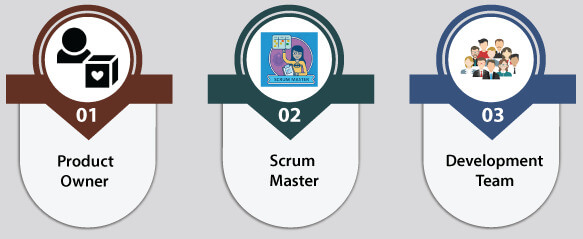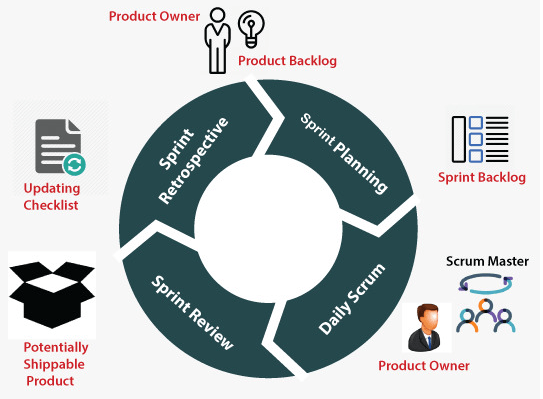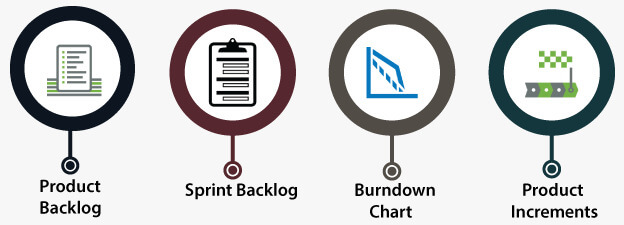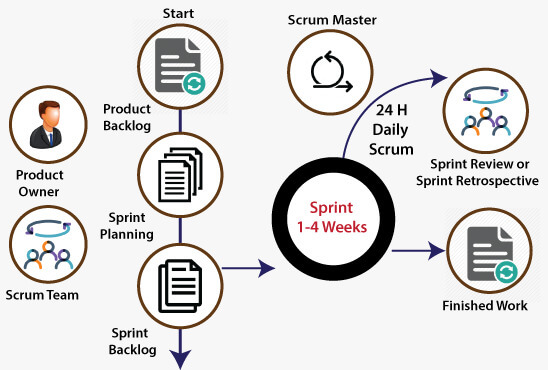Scrum MeaningScrum is one of the predominant methodologies, or we can conclude it as a framework with which the developers can efficiently address difficult problems. Being a lightweight framework that manages agile projects, it can successfully govern each type of iterative and incremental projects. It emphasizes splitting a complex problem into several small phases whereby making it easier to review and adapt all throughout its way. You can do the following with scrum:
The primary focus of an agile scrum master is to assign individuals in a cross-functional team along with the desired information, tools, and skills that are required to finish off their job. The scrum master holds much more privilege than a project manager in taking authoritative functions, i.e., managing several different software development processes and stages. From unblocking the obstacles to procuring tools and getting the information shared between teams, the scrum master is seen to perform several different tasks no matter what it takes to complete the project; it keeps everyone on task until it is done. For each project, the scrum master makes sure to perform the following tasks and meetings:
Benefits of Scrum Methodology1. REVENUE One can incrementally create new features inside the sprint with the help of Scrum. Whenever a sprint is ended, the scrum master facilitates the release of a hypothetically Increment of Software/Product much earlier in the development cycle. Despite waiting for the software to get finalized, it empowers to grasp the benefits in the former stage. 2. QUALITY Scrum plays an essential role in the development cycle of a product, especially when it comes to quality management. It maintains the quality by rigorously testing each sprint whereby it inspects the working of any Product or software on a regular basis as it develops. The scrum team keeps on checking for issues to get them resolved in time without hampering the quality of the product. 3. TRANSPARENCY Both the product owner and stakeholder can actively participate during the product development phase. It is considered to be one of the most transparent approaches, especially when it comes to project management. With the help of this approach, one can easily understand his/her roles and responsibilities. 4. COMMUNICATION AND COLLABORATION In short, we can understand the term daily scrum as short meet-ups that are often held to ensure whole team members have regular interaction, detect roadblocks, resolve problems and assimilate innovative ideas altogether. 5. DELIVER OFTEN VALUE The scrum methodology emphasizes delivering valuable services to its clients, which is one of the main concerns of software project management. 6. PROFITABILITY Each of the scrum attributes pays off by smart working that eventually results in greater efficiency and less wastage. If you withstand all of its ethics as well as ideologies, you will see all these factors bestow high profit. 7. SUSTAINABILITY Scrum is an agile framework that is specifically designed to attain sustainability. The scrum momentum can be easily maintained if it is correctly implemented by its team members. 8. SPEED TO MARKET Research suggests about 80% of all market leaders were first to market. As well as the higher revenue from incremental delivery, agile development supports the practice of early and regular releases. 9. MORE ENJOYABLE The active participation of Scrum team members leads to a healthy work environment. If the people work peacefully, the quality of their work will be more effective and efficient. Scrum frameworkThe scrum framework comprises of the three following categories:
Scrum RolesFollowing are the three major roles that are defined within the scrum. 
Events in ScrumMainly there are four events that you will come across throughout the process of the scrum. But before you move ahead, let's discuss "What is Sprint?". Basically, a sprint refers to a particular time period during which the scrum team members generate software products. The four events or ceremonies of Scrum Framework are as follows: 
Scrum ArtifactsScrum Artifacts refer to the physical data containing all the details of the project, which is required while developing a product. Scrum Artifacts include: 
How does a Scrum Process Work?
Step1: Initially, there is a product owner in the Scrum process who is responsible for creating a product backlog, a list of tasks and requirements required by the end product. It successfully prioritizes the product backlog. Step2: Next, all of the scrum team members get all together to plan for a sprint. After prioritizing the product backlog, the team then decides from where they should actually start working. This is when the subset of product backlog items turns into the sprint backlog. Step3: Then, there is a daily scrum, which is when all of the scrum team members interact with each other during the sprint to encounter progress as well as issues. This is mainly supervised by the scrum master to make sure that all of the scrum theories, rules, and practices are truly followed by the team members. Step4: As when the sprint is ended, the product owner organizes a sprint review meeting. In this meeting, the development team reveals whatever they have accomplished so far since the last sprint. And then, the product owner informs about what is yet to be achieved on the product backlog, followed by the estimated time in which the project has to be completed. Note: At the end of each sprint, the team should have a functioning piece of the product to show for their work.Step5: Next, the scrum team comes all together in a sprint retrospective meeting, where the team discusses what went well, what did not, and how they could have done it in a better way. This might be due to some technical issue or may be a team member is burdened with tasks. The decision-makers decide how to solve such issues and put up a plan to get rid of them in the next sprint. Step6: The cycle repeats for the remaining tasks in the product backlog. This goes on until either of the below-mentioned things happen:
Next TopicStrut Meaning
|
 For Videos Join Our Youtube Channel: Join Now
For Videos Join Our Youtube Channel: Join Now
Feedback
- Send your Feedback to [email protected]
Help Others, Please Share










